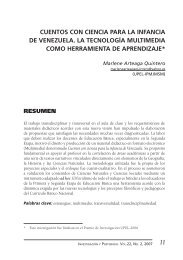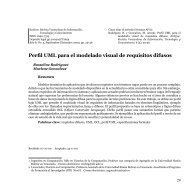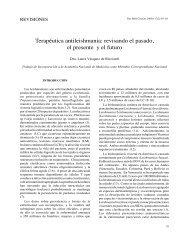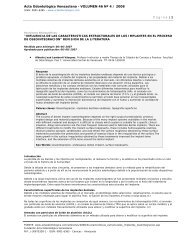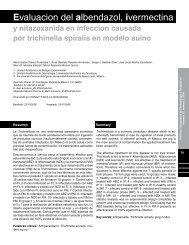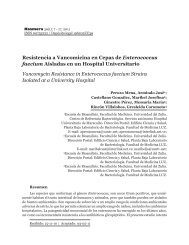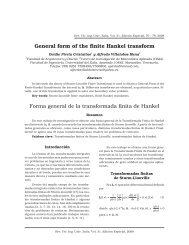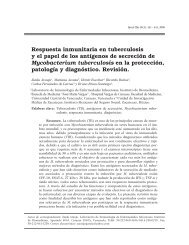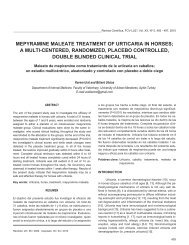la muerte celular programada en las plantas - SciELO
la muerte celular programada en las plantas - SciELO
la muerte celular programada en las plantas - SciELO
Create successful ePaper yourself
Turn your PDF publications into a flip-book with our unique Google optimized e-Paper software.
Rubinstein B (2000) Regu<strong>la</strong>tion of cell death in flower<br />
petals. P<strong>la</strong>nt Mol. Biol. 44: 303-318.<br />
Ryals J, Weymann K, Lawton K, Friedrich L,<br />
Ellis D, Steiner HY, Johnson J, De<strong>la</strong>ney DP,<br />
Jesse T, Vos P, Uknes S (1997) The Arabidopsis<br />
NIM1 protein shows homology to the<br />
mammalian transcription factor inhibitor IKB.<br />
P<strong>la</strong>nt Cell 9: 425-439.<br />
Sánchez P, de Torres Zaba<strong>la</strong> M, Grant M (2000)<br />
AtBI-1, a p<strong>la</strong>nt homologue of Bax inhibitor-1,<br />
suppresses Bax-induced cell death in yeast and<br />
is rapidly upregu<strong>la</strong>ted during wounding and pathog<strong>en</strong><br />
chall<strong>en</strong>ge. P<strong>la</strong>nt J. 21: 393-399.<br />
Sax JK, Fei P, Murphy ME, Bernhard E, Korsmeyer<br />
SJ, El Deiry WS (2002) BID regu<strong>la</strong>tion by p53<br />
contributes to chemos<strong>en</strong>sitivity. Nat. Rev. Cell<br />
Biol. 4: 842-849.<br />
Seay M, Patel S, Dinesh-Kumar SP (2006) Autophagy<br />
and p<strong>la</strong>nt innate immunity. Cell Microbiol.<br />
8: 899-906.<br />
Sh<strong>en</strong> HM, Pervaizs S (2006) TNF receptor superfamily-induced<br />
cell death: redox-dep<strong>en</strong>d<strong>en</strong>t execution.<br />
Faseb J. 20: 1589-1598.<br />
Shi Y (2002) Mechanisms of caspase inhibition<br />
and activation during apoptosis. Mol. Cell<br />
9: 459-470.<br />
Shirasu K, Schulze-Lefert P (2000) Regu<strong>la</strong>tors of<br />
cell death in disease resistance. P<strong>la</strong>nt Mol. Biol.<br />
44: 371-385.<br />
Stone SL, Anderson EM, Mull<strong>en</strong> RT, Goring DR<br />
(2003) ARC1 is an E3 ubiquitin ligase and<br />
promotes the ubiquitination of proteins during<br />
the rejection of selfincompatible Brassica<br />
poll<strong>en</strong>. P<strong>la</strong>nt Cell 15: 885-898.<br />
Strasser A, O’Connor L, Dixit VM (2000)<br />
Apoptosis Signaling. Annu. Rev. Biochem.<br />
69: 217-245.<br />
Sugiyama M, Ito J, Aoyagi S, Fukuda H<br />
(2000) Endonucleases. P<strong>la</strong>nt Mol. Biol.<br />
44: 387-397.<br />
Sun YL, Zhao Y, Hong X, Zhai ZH (1999)<br />
Cytochrome c release and caspase activation<br />
during nemadione-induced apoptosis in<br />
p<strong>la</strong>nts. FEBS Lett. 462: 317-321.<br />
Tian RH, Zhang GI, Yan CH, Dai YR (2000)<br />
Involvem<strong>en</strong>t of poly(ADP-ribose) and activation<br />
of capase-3-like protease in heat<br />
shock-induced apoptosis in tobacco susp<strong>en</strong>sion<br />
cells. FEBS Lett. 474: 11-15.<br />
Tiwari BS, Bel<strong>en</strong>ghi B, Levine A (2002) Oxidative<br />
stress increased respiration and<br />
g<strong>en</strong>eration of reactive oxyg<strong>en</strong> species, resulting<br />
in ATP depletion, op<strong>en</strong>ing of mitochondrial<br />
permeability transition, and<br />
programmed cell death. P<strong>la</strong>nt Physiol.<br />
128: 1271-1281.<br />
Ur<strong>en</strong> AG, O’Rourke K, Aravind LA, Pisabarro<br />
MT, Seshagiri S, Koonin EV, Dixit<br />
VM (2000) Id<strong>en</strong>tification of paracaspases<br />
and metacaspases: two anci<strong>en</strong>t families of<br />
caspase-like proteins, one of which p<strong>la</strong>ys<br />
a key role in MALT lymphoma. Mol. Cell<br />
6: 961-967.<br />
Vaux DL, Korsmeyer SJ (1999) Cell Death in<br />
Developm<strong>en</strong>t. Cell 96: 245-254.<br />
Van der Hoorn RA, Jones JD (2004) The p<strong>la</strong>nt<br />
proteolytic machinery and its role in def<strong>en</strong>ce.<br />
Curr. Opin. P<strong>la</strong>nt Biol. 7: 400-407.<br />
PROGRAMMED CELL DEATh IN PLANTS: IT IS SIMILAR TO “APOPTOSIS” IN ANIMALS?<br />
Yornayser Pérez Delgado, Iván Galindo Castro and Francisco Arvelo<br />
SUMMARY<br />
Programmed cell death (PCD) is ess<strong>en</strong>tial to maintain tissue<br />
homeostasis in many forms of life. As in animals, in p<strong>la</strong>nts PCD<br />
is the mechanism whereby a series of physiological processes,<br />
such as germination, differ<strong>en</strong>tiation, growth, reproduction and<br />
seed developm<strong>en</strong>t, are regu<strong>la</strong>ted. PCD p<strong>la</strong>ys a key role in other<br />
processes such as resistance to unfavorable <strong>en</strong>vironm<strong>en</strong>tal conditions.<br />
Unlike animal models, PCD in p<strong>la</strong>nts has be<strong>en</strong> scarcely<br />
described at molecu<strong>la</strong>r level, which has giv<strong>en</strong> rise to controversy<br />
Wal<strong>en</strong>sy L (2006) BCL-2 in the crosshairs: tipping<br />
the ba<strong>la</strong>nce of life and death. Cell<br />
Death Diff. 13: 1339-1350.<br />
Wang H, Li J, Bostock RM, Gilchrist DG<br />
(1996) Apoptosis: a functional paradigm for<br />
programmed p<strong>la</strong>nt cell death induced by a<br />
host-selective phytotoxin and invoked during<br />
developm<strong>en</strong>t. P<strong>la</strong>nt Cell 8: 375-391.<br />
Weigel RR, Pfitzner UM, Gatz C (2005) Interaction<br />
of NIMIN1 with NPR1 modu<strong>la</strong>tes PR<br />
g<strong>en</strong>e expression in Arabidopsis. P<strong>la</strong>nt Cell<br />
17: 1279-1291.<br />
Woltering EJ, van der B<strong>en</strong>t A, Hoeberichts FA<br />
(2002) Do p<strong>la</strong>nt caspases exist? P<strong>la</strong>nt Physiol.<br />
130: 1764-1769.<br />
Wu H, Cheung AY (2000) Programmed cell<br />
death in p<strong>la</strong>nt reproduction. P<strong>la</strong>nt Mol.<br />
Biol. 44: 267-281.<br />
Yan N, Huh HR, Schirf V, Delemer B, Hay BA,<br />
Shi Y (2006) Structure and activation mechanism<br />
of the Drosophi<strong>la</strong> initiator caspase<br />
Dronc. J. Biol. Chem. 281: 8667-8674.<br />
Young TE, Gallie DR (2000) Programmed cell<br />
death during <strong>en</strong>dosperm developm<strong>en</strong>t. P<strong>la</strong>nt<br />
Mol. Biol. 44: 283-301.<br />
Yu L, L<strong>en</strong>ardo MJ, Baehrecke EH (2004) Autophagy<br />
and caspasas: a new death program.<br />
Cell Cycle 3: 1124-1126.<br />
Zhang HK, Zhang X, Mao BZ, Li Q, He ZH<br />
(2004) Alpha-picolinic acid, a fungal toxin<br />
and mammal apoptosis-inducing ag<strong>en</strong>t, elicits<br />
hypers<strong>en</strong>sitive-like response and <strong>en</strong>hances<br />
disease resistance in rice. Cell Res.<br />
14: 27-33.<br />
about the parallelism betwe<strong>en</strong> this type of PCD and the process<br />
known as apoptosis in animals. Nevertheless, evid<strong>en</strong>ces have<br />
come forth <strong>la</strong>tely that allow to conclude that apoptosis occurs in<br />
p<strong>la</strong>nts as well. In this review, rec<strong>en</strong>t findings in this area in the<br />
p<strong>la</strong>nt kingdom are analyzed, which throw light on the modu<strong>la</strong>tion<br />
of the p<strong>la</strong>nt response against a diverse biotic and abiotic<br />
stress ag<strong>en</strong>t, paving the way for their use in g<strong>en</strong>etic improvem<strong>en</strong>t<br />
programs for strategic crops.<br />
A MORTE CELULAR PROGRAMADA NAS PLANTAS: é SEMELhANTE A “APOPTOSE” EM ANIMAIS?<br />
Yornayser Pérez Delgado, Iván Galindo Castro e Francisco Arvelo<br />
RESUMO<br />
A morte celu<strong>la</strong>r <strong>programada</strong> (MCP) é ess<strong>en</strong>cial para manter<br />
a homeostase tissu<strong>la</strong>r em muitas formas de vida. Nas p<strong>la</strong>ntas,<br />
de igual forma que nos animais, a MCP é o mecanismo pelo<br />
qual se regu<strong>la</strong>m uma série de processos fisiológicos tais como a<br />
germinação, difer<strong>en</strong>ciação, crescim<strong>en</strong>to, reprodução e des<strong>en</strong>volvim<strong>en</strong>to<br />
de sem<strong>en</strong>tes. A MCP também tem um papel importante<br />
em outros processos como o de resistência a condições ambi<strong>en</strong>tais<br />
desfavoráveis. Difer<strong>en</strong>tem<strong>en</strong>te dos modelos animais, a MCP<br />
em p<strong>la</strong>ntas é pouco descrita no nível molecu<strong>la</strong>r, o que há gerado<br />
debates sobre o paralelismo <strong>en</strong>tre este tipo de morte <strong>programada</strong><br />
e o processo conhecido em animais como apoptose. No <strong>en</strong>tanto,<br />
nos últimos anos tem surgido evidências importantes que permitem<br />
concluir que nas p<strong>la</strong>ntas existe tal processo. Nesta revisão<br />
se analisam descobertas rec<strong>en</strong>tes no reino vegetal para esta<br />
área, que começam a vislumbrar elem<strong>en</strong>tos chave sobre a modu<strong>la</strong>ção<br />
da resposta da p<strong>la</strong>nta diante de muitos diversos fatores de<br />
estresse, tanto biótico como abióticos e abrindo, além disso, a<br />
possibilidade de utilizá-los em programas de melhoram<strong>en</strong>to g<strong>en</strong>ético<br />
de it<strong>en</strong>s agríco<strong>la</strong>s estratégicos.<br />
DEC 2007, VOL. 32 Nº 12 819




